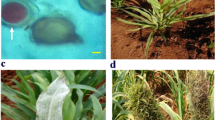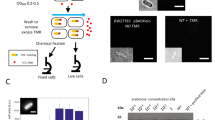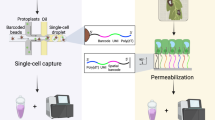Abstract
Fungi are a diverse group of eukaryotic organisms whose activities are intricately linked to the lives of human beings. Their involvement in plant productivity, as agents of human diseases, as sources of medicines and enzymes and as model experimental organisms has necessitated the development of sensitive and specific techniques for tracking the organisms and their protein products. Techniques employing highly specific monoclonal antibodies have allowed the visualization of fungi in their natural environments and have facilitated the study of their antigens at the subcellular level. Here, we describe three such techniques, immunofluorescence (IF), immuno-enzymatic staining (IES) and immunoelectron microscopy (IEM), that have found widespread applicability in studies of fungal biology, and which can also be adapted for use in the study of other eukaryotic organisms. Results from the IF and IES procedures can be obtained within 4–5 h. Sample preparation for IEM takes approximately 4 days. Gold labeling and visualization of samples can be completed within 4 h.
This is a preview of subscription content, access via your institution
Access options
Subscribe to this journal
Receive 12 print issues and online access
$259.00 per year
only $21.58 per issue
Buy this article
- Purchase on Springer Link
- Instant access to full article PDF
Prices may be subject to local taxes which are calculated during checkout



Similar content being viewed by others
References
Thornton, C.R., Pitt, D., Wakley, G.E. & Talbot, N.J. Production of a monoclonal antibody specific to the genus Trichoderma and closely related fungi, and its use to detect Trichoderma spp. in naturally infested composts. Microbiology 148, 1263–1279 (2002).
Thornton, C.R. An immunological approach to studying the saprotrophic growth dynamics of Trichoderma species during antagonistic interactions with Rhizoctonia solani in a soil-less mix. Environ. Microbiol. 6, 323–334 (2004).
Wosten, H.A.B., Moukha, S.M., Sietsma, J.H. & Wessels, J.G.H. Localization of growth and secretion of proteins in Aspergillus niger. J. Gen. Microbiol. 137, 2017–2023 (1991).
Goffeau, A. et al. Life with 6000 genes. Science 274, 546–563 (1996).
Nierman et al. Genomic sequence of the pathogenic and allergenic filamentous fungus Aspergillus fumigatus. Nature 438, 1151–1156 (2005).
Dean, R.A. et al. The genome sequence of the rice blast fungus Magnaporthe grisea. Nature 434, 980–986 (2005).
Machida, M. et al. Genome sequencing and analysis of Aspergillus oryzae. Nature 438, 1092–1093 (2005).
Chalfie, N. et al. Green fluorescent protein as a marker for gene expression. Science 263, 802–805 (1994).
Gordon, C.L. et al. Glucoamylase::green fluorescent protein fusions to monitor protein secretion in Aspergillus niger. Microbiology 146, 415–426 (2000).
Kershaw, M.J., Thornton, C.R., Wakley, G.E. & Talbot, N.J. Four conserved intramolecular disulphide linkages are required for secretion and cell wall localization of a hydrophobin during fungal morphogenesis. Mol. Microbiol. 56, 117–125 (2005).
Momany, M. Cell biology of the duplication cycle in fungi. in Molecular and Cellular Biology of Filamentous Fungi: A Practical Approach (ed. Talbot, N.J.) 7119–7125 (Oxford University Press, Oxford, UK, 2001).
Harlow, E. & Lane, D. Antibodies: A Laboratory Manual. (Cold Spring Harbor Laboratory Press, Cold Spring Harbor, NY, 1988).
Thornton, C.R. Immunological methods for fungi. in Molecular and Cellular Biology of Filamentous Fungi: A Practical Approach (ed. Talbot, N.J.) 12.227–12.257 (Oxford University Press, Oxford, UK, 2001).
O'Connell, R.J. & Carzaniga, R. Electron microscopy of filamentous fungi. in Molecular and Cellular Biology of Filamentous Fungi: A Practical Approach (ed. Talbot, N.J.) 10.175–10.208 (Oxford University Press, Oxford, UK, 2001).
Gilbert, M.J., Thornton, C.R., Wakley, G.E. & Talbot, N.J. A P-type ATPase required for rice blast disease and induction of host resistance. Nature 440, 535–539 (2006).
Hyatt, M.A. Chemical fixation. in Principles and Techniques of Electron Microscopy Biological Applications 3rd edn. 1.1–1.7 (MacMillan Press, London, UK, 1989).
Griffiths, G. Fine Structure Immuno-cytochemistry (Springer-Verlag, Berlin, Germany, 1993).
Author information
Authors and Affiliations
Corresponding authors
Ethics declarations
Competing interests
The authors declare no competing financial interests.
Rights and permissions
About this article
Cite this article
Thornton, C., Talbot, N. Immunofluorescence microscopy and immunogold EM for investigating fungal infection of plants. Nat Protoc 1, 2506–2511 (2006). https://doi.org/10.1038/nprot.2006.347
Published:
Issue Date:
DOI: https://doi.org/10.1038/nprot.2006.347
This article is cited by
-
Characterization of NAC domain transcription factors implicated in control of vascular cell differentiation in Arabidopsis and Populus
Planta (2010)
-
Under pressure: investigating the biology of plant infection by Magnaporthe oryzae
Nature Reviews Microbiology (2009)
-
Tracking fungi in soil with monoclonal antibodies
European Journal of Plant Pathology (2008)
Comments
By submitting a comment you agree to abide by our Terms and Community Guidelines. If you find something abusive or that does not comply with our terms or guidelines please flag it as inappropriate.



